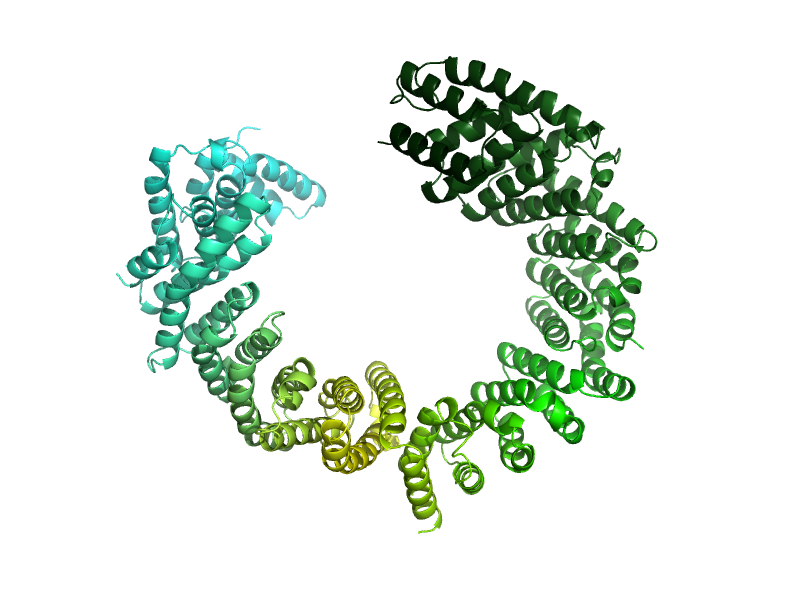Spectrumany: Difference between revisions
Jump to navigation
Jump to search
(support "resi" as expression) |
(added figure) |
||
| Line 1: | Line 1: | ||
[[File:SpectrumanyExample.png|300px|thumb|right|Coloring with a gradient of different green shades]] | |||
This script works similar to the [[spectrum]] command, but instead of predefined palettes, any color sequence can be used. | This script works similar to the [[spectrum]] command, but instead of predefined palettes, any color sequence can be used. | ||
Revision as of 09:53, 18 February 2011
This script works similar to the spectrum command, but instead of predefined palettes, any color sequence can be used.
The color sequence is given by a space separated list of colors, so palette "red_white_blue" is the same as color sequence "red white blue".
Example
fetch 2x19
# these two produce the same result
spectrum count, red_white_blue, chain B
spectrumany count, red white blue, chain B
# gradient of different green colors
spectrumany count, smudge palegreen limegreen limon green forest, chain B
The Script
'''
(c) 2010 Thomas Holder
'''
from pymol import cmd, stored
def spectrumany(expression, color_list, selection='(all)', minimum=None, maximum=None):
'''
DESCRIPTION
Define a color spectrum with as many color-stops as you like (at least 2).
USAGE
spectrumany expression, color_list [, selection [, minimum [, maximum ]]]
ARGUMENTS
expression = count, resi, b, q, or pc: respectively, atom count, residue
index, temperature factor, occupancy, or partial charge {default: count}
color_list = string: Space separated list of colors
... all other arguments like with `spectrum` command
EXAMPLE
spectrumany count, forest green yellow white
spectrumany b, red yellow white, (polymer), maximum=100.0
SEE ALSO
spectrum
'''
colors = color_list.split()
if len(colors) < 2:
print 'failed! please provide at least 2 colors'
return
colvec = [cmd.get_color_tuple(i) for i in colors]
parts = len(colvec) - 1
count_expr = 'index'
expression = {'pc': 'partial_charge', 'fc': 'formal_charge',
'count': count_expr}.get(expression, expression)
minmax_expr = {'resi': 'resv'}.get(expression, expression)
discrete_expr = ['index', 'resi']
if cmd.count_atoms(selection) == 0:
print 'empty selection'
return
if None in [minimum, maximum]:
stored.e = list()
cmd.iterate(selection, 'stored.e.append(%s)' % (minmax_expr))
if minimum is None:
minimum = min(stored.e)
if maximum is None:
maximum = max(stored.e)
minimum, maximum = float(minimum), float(maximum)
print ' Spectrum: range (%.5f to %.5f)' % (minimum, maximum)
if maximum == minimum:
print 'no spectrum possible, only equal %s values' % (expression)
return
if expression in discrete_expr:
val_range = int(maximum - minimum + 1)
else:
val_range = maximum - minimum
cmd.color(colors[0], selection)
steps = 60 / parts
steps_total = steps * parts
val_start = minimum
for p in range(parts):
for i in range(steps):
ii = float(i)/steps
col_list = [colvec[p+1][j] * ii + colvec[p][j] * (1.0 - ii) for j in range(3)]
col_name = '0x%02x%02x%02x' % tuple(i * 255 for i in col_list)
val_end = val_range * (i + 1 + p * steps) / steps_total + minimum
if expression in discrete_expr:
cmd.color(col_name, '(%s) and %s %d-%d' % (selection, expression, val_start, val_end))
else:
cmd.color(col_name, '(%s) and %s > %f' % (selection, expression, val_start))
val_start = val_end
cmd.extend('spectrumany', spectrumany)
